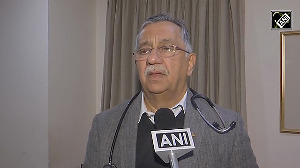On two major fronts, the performance of the US economy this year is going to have a significant impact on India's economic prospects. One, there is the growing political confrontation on outsourcing, an activity, which has become the leading employment generator in India.
While few people think that political compulsions will eventually triumph over the profit motive, the issue is likely to be kept alive all the way to the presidential election in November. Its prominence in the campaign will be directly proportional to the unemployment situation in the country.
Two, the outflow of dollars from the US to the rest of the world as a consequence of the country's trade deficit, has not been matched by an inflow of foreign investment.
In the past, the "twin deficit" -- trade and fiscal -- scenario that the US is currently in was accompanied by an appreciating dollar as foreign investors were lured into the US with relatively high interest rates.
This time around, interest rates are too low to attract too much money, resulting in the dollar depreciating around the globe, with the exception of countries like China, who have pegged their currencies to the dollar.
One of the consequences of this, as was pointed out by Martin Wolf in an article, is an exaggerated commodity dollar price upswing. While there undoubtedly is an upturn in the commodity cycle, its magnitude is far from being a source of concern when measured in pounds, euros or yen.
From India's perspective, the seemingly endless inflow of dollars has provided a major challenge to policymakers over the last few months. This is perhaps the first time in its history that the Reserve Bank of India has had to deal with an appreciating rupee.
Its ability to resist the pressure without allowing money supply to surge is limited by the stock of government securities it owns, and it has virtually exhausted that capacity.
In such a situation, the central bank essentially has two choices -- either continue to resist the upward pressure on the currency by buying up dollars and allowing the money supply to rise correspondingly, or cry off and let the currency find its own level.
Since it did not find either of these two options palatable, the RBI launched the Market Stabilization Scheme. The special purpose bonds under this scheme enhance its capacity to pursue the policy of reserve accumulation without monetary expansion.
While it is possible to interpret the RBI's motivation for the scheme as a commitment to preventing rupee appreciation, the reality may be somewhat different. The scheme essentially replenishes the RBI's war chest, signalling to the markets that it is in a position to continue on the current policy course, should it choose.
Whether it uses the scheme to the full extent or not, the fact is that, without it, markets would simply have assumed that either the rupee or the money stock was going to increase; given the RBI's commitment to price stability, it was more likely going to be the rupee.
Guaranteed appreciation would have induced even larger inflows, compounding the problem. The question is: what is the minimum size of the stabilisation scheme that would make it a genuinely credible threat?
Having initially capped the scheme at Rs 60,000 crore (Rs 600 billion) worth of bonds, the RBI sold Rs 12,500 crore (Rs 125 billion) worth in the first eight days. The average monthly accretion of reserves during 2003-04, in rupee terms, was almost Rs 12,000 crore (Rs 120 billion).
If this pattern persists, the scheme will reach its limit in five months; if the first eight days are an indication, it may even be sooner than that. It may well be enhanced once or twice, but this will only underscore the fact that it is, at best, a temporary measure and sooner or later, the RBI will have to deal with the appreciation versus inflation dilemma.
This is where the monetary behaviour of the US becomes critical. If things were to change significantly there, rekindling the appetite for US assets among foreign portfolio investors, the magnitude of inflows into India (and other countries) would diminish, and the world would go back to a more familiar twin deficits -- appreciating dollar scenario. That, of course, would pose its own problems, but that is another story.
As indicated above, US interest rates are currently at historically low levels. Yields on short-term government securities are less than 1 per cent on an annualised basis. So, purely from where they are now, it is not difficult to argue that there is no place to go but up. The question is: when?
Major macroeconomic indicators clearly suggest a rise during the course of the year; by the second half, it appears almost certain. Growth will be quite robust, with many forecasts converging around 4 per cent for calendar 2004. High oil prices are a concern, but even here, in real terms, they are not at levels, which seriously threaten the expansion.
This, in combination with the fiscal deficit, should exert upward pressure. Although the unemployment rate has been quite obstinate at around 5.6-5.7 per cent, the number of jobs created in March went up appreciably to above 3,00,000 from an average of around 1,30,000 in the last few months. If this trend continues, it may push the outsourcing debate off centre stage.
Inflation has not been a factor even with the depreciated dollar; as interest rates increase and the dollar begins to appreciate, the inflationary accompaniment to a robust recovery will be muted.
Of course, the rising dollar will make imports cheaper and aggravate the trade deficit, which again raises concerns about US positions in the global trade negotiations, but that is also another story.
But, there is another argument in favour of a relatively sharp policy-induced rise in interest rates, articulated by, for instance, Stephen Roach, global chief economist of Morgan Stanley.
The argument is that the Federal Reserve is currently out of ammunition to deal with an unanticipated demand shock. Because interest rates are already so low, there is simply no room left for an expansionary monetary policy if the need were to arise. The Fed should, therefore, use the first opportunity it gets to raise rates to a level, which gives it enough room to manoeuvre.
This is, in fact, the reasoning behind the market stabilisation scheme. The key message is that a central bank should never be in a position in which its arsenal is empty. Effective monetary policy is as much a matter of preparedness as implementation.
The writer is chief economist, Crisil. The views expressed are personal





 © 2025 Rediff.com -
© 2025 Rediff.com -